ON SINES OF EXQUISITE PLEASURE
written in 4 December 2022
An odd situation regarding possible retroactive forgery has appeared on the cassette scene. This post aims to document most of the info I’ve collected regarding this.
ATTENTION: This post is still under construction, and will probably be updated as more research is done and new info is found.
See the revision history at the end of the page for info about updates!
Also check out the Discogs forum page where most discussion regarding this is being held.
I’m into digging for underground (or sometimes not so underground, but not so mainstream music), whether it be through YouTube or other such platforms.
But the other day I came across something very strange. I was scrolling through my YouTube feed as one does and a video got my attention. An upload of a 1982 cassette called “Modular Systems” by “Sines of Exquisite Pleasure”. But for some reason, something felt off about this one.
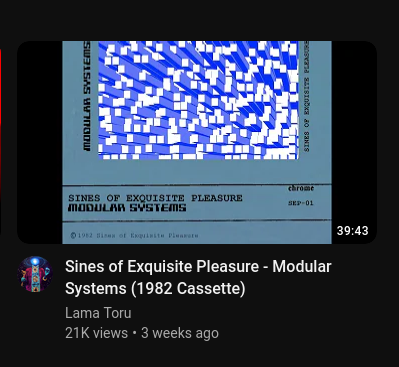
I opened the video. Seeing the J-Card in higher resolution and listening to the crisp and clear audio, that unease grew stronger. I couldn’t help but feel like this wasn’t real. I decided to do some digging. I started by searching for Sines of Exquisite Pleasure in quotes on Google - this will make it so Google only searches for exact matches of the words you put between quotes. I found almost no information. But I did find what could be a few leads…
American Tapeworks
Although not the first result, something piqued my interest: a website called American Tapeworks showed up on the results. They are a label that focuses on reproductions of old underground cassette releases as well as new cassette releases, which is a very nice initiative. At the time of writing, the following releases are available from them:
- Lauri Paisley: MemorExodus (1982) [ATW 0122]
- Sines of Exquisite Pleasure: Modular Systems (1982) [ATW 0222]
- Port Said: Through Veils (1981) [ATW 0322]
- Carl Matthews: Freewheel to Freedom (1981) [ATW 0422]
- Young Scientist: Over Low Trees… (1979) [ATW 0522]
- D.A. Dettmar + Gerald Toon: Synthesis (1980) [ATW 0622]
To preserve this list, I requested that the Internet Archive WayBack Machine make a capture of the American Tapeworks page as I saw it - that capture is available here for future reference. I did some research on the other artists listed here, so I’ll briefly touch on that:
Lauri Paisley
Everything points towards Lauri being legit: There are many search results for her name, including:
- A review of MemorExodus on the October/1983 issue of Polyphony
- A mention of an article of hers on Synthesis Vol. 2 #1 in the June/1990 (36) issue of Factsheet Five
- A listing for a copy of Laurie’s “Real-to-Reel” in the March/1984 issue of CLEM (Contact List of Electronic Music)
- A mention of an interview Laurie did with someone named Joe Schmidt in the April/1986 issue of CLEM
- A reference to her in a review of Nightcrawler’s Spacewalk LP on the Summer 1986 (5) edition of Sound Choice
- Music of hers in the 8/May/1988 show of No Pigeonholes
- Music of hers in the 15/March/1988 Women’s Day Special show of No Pigeonholes
Port Said
Port Said is verifiably legitimate. It was a project by Stefan Tischler and Keith “Keeler” Walsh. The project seems to have been short lived, but both artists did go on to have solo carreers. There is ample evidence of Port Said’s legitimacy, though it would be nice to see their stuff archived more thoroughly, as some information has been lost to time.
Carl Matthews
Carl Matthews seems legitimate. Many copies of his work are available for sale on Discogs from all over the world, and even though most of the work on his Discogs catalog was worked on by one user, there are mentions of his work outside of Discogs, notably about an LP set containing his tapes released under the Mirage label.
Young Scientist
The Discogs page for Over Low Trees has existed since 2008, authored by users who don’t seem to have any connection to Sines of Exquisite Pleasure. This one could use more sources, but I’m on the side of legitimate with this one.
D.A. Dettmar & Gerald Toon
Dettmar and Toon are legitimate artists.
There isn’t a lot of info about Synthesis online, but there are music blog entries dating back to 2007 about this album (1, 2), and in a comment in the first one someone points to an altervista URL that contained more information, but it is unfortunately no longer availaable in eitther the live web or the WayBack Machine.
Del Dettmar was a keyboard/synth player as well as sound engineer in Hawkwind. He is notable enough to have his own Wikipedia page.
Gerald Toon collaborated with Del Dettmar further in a track on Melodic Energy Commission’s Migration of the Snails (sources: Prog Archives, Discogs). Interestingly, he also collaborated with Port Said on Traveller’s Companion, as evidenced by the credits on the inside of the J-Card. He later on also mixed Stefan Tischler (of Port Said) and Blair Petrie’s collaborative tape Gorgons and Gargoyles, for which he was once again credited inside the J-Card.
Concluding American Tapeworks
Apart from information on other artists, the American Tapeworks website didn’t provide much more information on the topic of Modular Systems. I decided to start looking elsewhere, but have since contacted American Tapeworks requesting information about the album.
Discogs
The album page
Naturally, there’s a Discogs page for the album. Funnily enough, the result Google gave me was for the 2022 “reissue” of the album, which briefly made me feel as if I had found the smoking gun. I moved on over to the master release, and found a 1982 release listed. There were images of the actual tape available! So maybe it was just me misjudging the album?
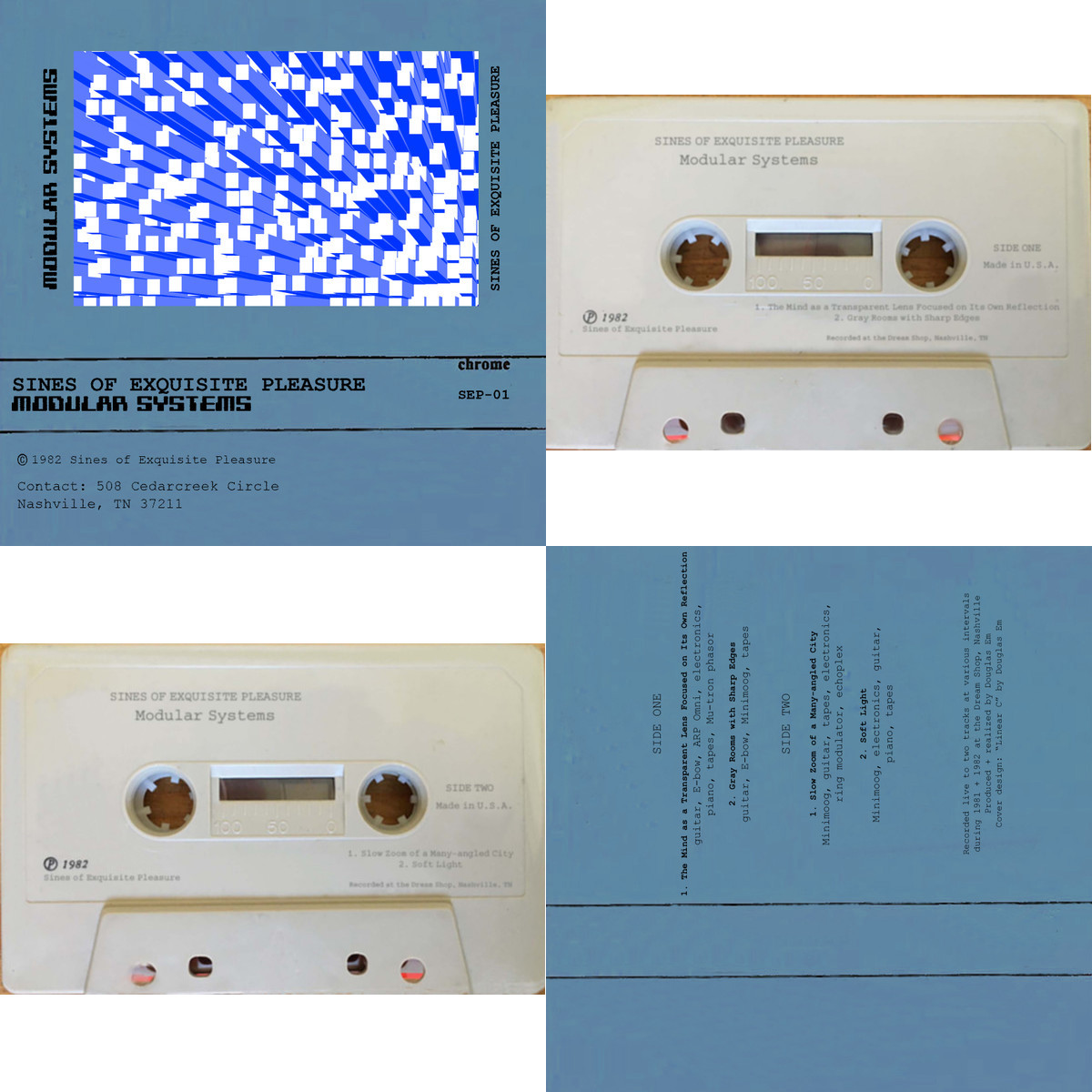
These are the images available on the Discogs listing as of the writing of this post. I haven’t resized, cleaned or modified them, just tiled them in GIMP keeping the (somewhat low) resolution that Discogs served them to me in. The only thing different is that the tape’s images weren’t square shaped, so I just put a white background to keep them centered.
The first weird thing is that the J-Card has no folding, damage, dust or scanning artifacts. It really just looks pristine, at least when it comes to the text and the illustration on the front. There are some imperfections, but they’re of the kind that are easily done digitally and look kind of silly. Worth noting is the very sharp, very digital-looking writing in what appears to be Courier.
As for the cassette images themselves, it’s way less conclusive but to me they just look like someone overlaid Courier text on top of a picture of a cassette. Discogs user nickleb474 also noticed that both the inside and outside images seemed to have very similar imperfections. They have produced the following animation, which I’ve been given permission to reproduce:
The bright artifact on the left side as well as the dark artifact on the lower right are not natural of say, stains on a J-Card, since if that was the case they’d be horizontally flipped on the opposite side. And although the line appears to have been made stronger on the outside of the J-Card, the lines have precisely the same imperfections which look like an attempt to emulate a line drawn with pen.
Something that got my attention on my first look into this is that there was one comment also doubting the veracity of this release. Unfortunately that comment along with my similarly doubtful response to it have been lost since the release was removed due to a majority vote.
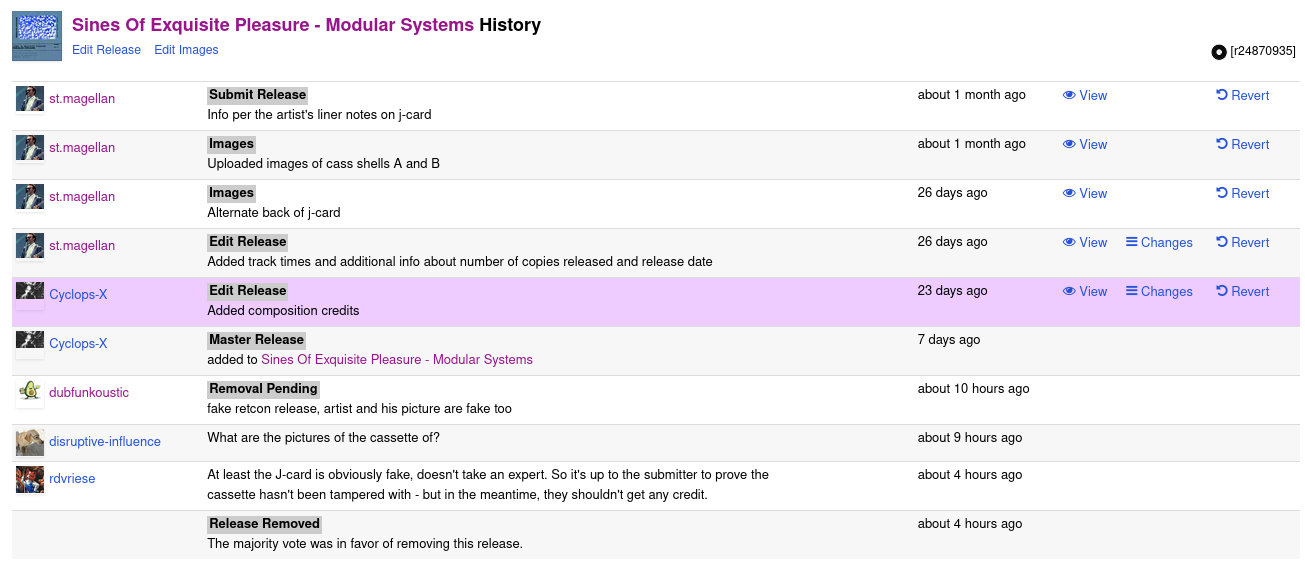
One thing that got my attention was the “Alternate back of j-card” entry, since the release only seemed to have one picture of the back of the J-Card. Turns out that before this revision, st.magellan had uploaded a slightly different J-Card image.
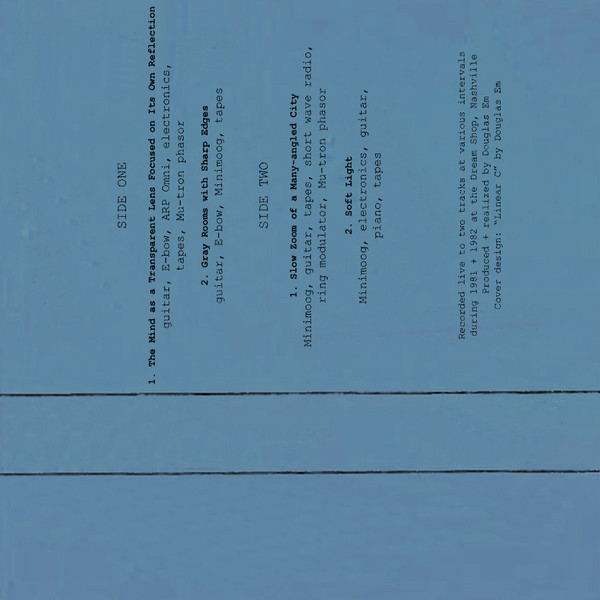
There are only two instrument changes, but the text is also notably sharper.
There’s some other stuff that we can dig into here, but we’ll come back to it.
Who’s the artist anyway?
I thought I’d also check out the artist page for Sines of Exquisite Pleasure. It has the following description:
Early ambient/minimalist project of Douglas Em, from Nashville, Tennessee. Em employed guitar, synthesizer (almost exclusively minimoog), tapes, electronics, loops and delays to create repetitive, hypnotic pieces similar in design and construction to the work of Robert Fripp and Brian Eno on No Pussyfooting and Evening Star, as well as Eno’s more personal experiments with the modular design of sound on Discreet Music and Music for Airports. He has also acknowledged the influence of John Cage, Terry Riley, Glenn Branca, and John Adams on his work. Under the name Sines of Exquisite Pleasure, Em released two cassette albums, Modular Systems (1982) and Music for Hospitals (1984), and one DAT album, Cinema Zero (1988).
I thought I’d check out Douglas Em’s page. This is the description available there:
U.S. minimalist/ambient composer born 1961 in Nashville, TN. Em studied electronic music composition and film production at the University of South Carolina, where he received his M.A. in 1986. Influenced primarily by the works of John Cage, Terry Riley, Brian Eno, and Robert Fripp, Em’s “modular systems music” uses mathematical models of harmonic structure to create random closed system sound events. Active throughout the 1980s, Em’s work encompassed commissions from Vanderbilt University, the Tennessee Council for the Arts, the Von Braun Center, and Reed College. During this period, he released two cassette-only albums, Modular Systems (1982) and Music for Hospitals (1984), as well as a privately distributed limited edition DAT, Cinema Zero (1988), that contained work from his various sound installation performances. Other works include Studies in Luminescence (1991), Energy Structures for Guitar & Electronic Devices (1993) and Music for the Films of Maya Deren (1997). He has been a National Endowment for the Arts Fellow and has published a book on postmodern music theory called Random Sines: An Introduction to the Dynamics of Modular Sound Design (1994), funded by a grant from the NEA. Beginning in the late 1980s and throughout the 1990s, he taught music theory and electronic music composition at Concordia University.
There are also two accompanying images, which I’ll reproduce here:

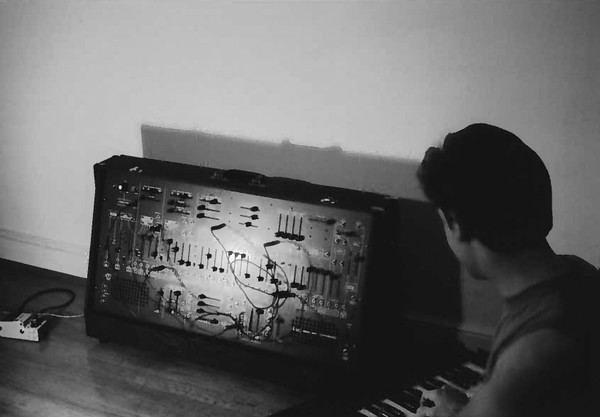
Now, it’s very odd that the only two available pictures of the artist are a terribly low quality one and a quite impressively high quality one for the 1980s, but what’s really the most odd thing here is the first picture. I couldn’t shake off the feeling that this was a picture of one person with their face erased and someone else’s face overlaid on top of theirs. For reference purposes, here’s two edits of the picture I did: on the left, I did a simple level adjustment to get the black and white points roughly correct, and on the right I adjusted the gamma on the left image to highlight what I feel is the “overlaid” effect.
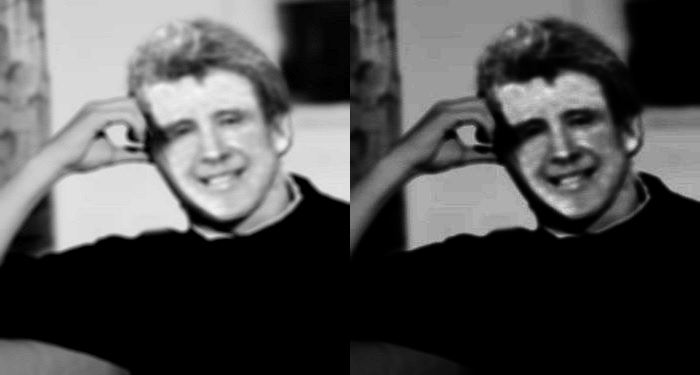
Note how on the right picture, the “outer” parts of the face are lighter and blurrier than the comparatively sharper “inner” part of the face. You can see a “border” of sorts which I believe was the boundary of the feathered overlay of the new face.
Discogs user dubfunkoustic later found out that Cyclops-X had uploaded a color version of the second picture of Douglas Em, but subsequently disabled it.
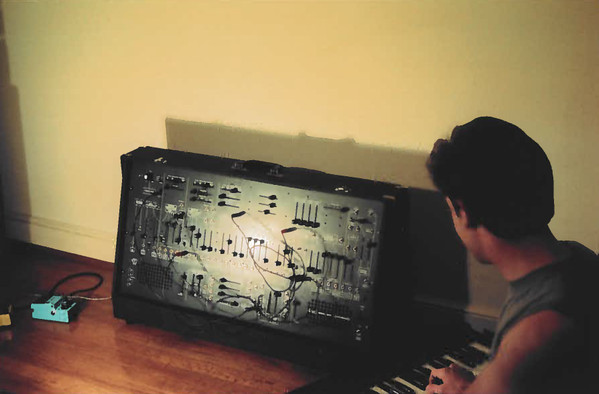
dubfunkoustic as well as other users find this version of the image to appear photoshopped. I believe it’s a legitimate picture, but as I’ve stated in the Discogs thread, it may be that due to the fact that Discogs is serving me low quality versions of all images.
Unfortunately, apart from this inconclusive info, there wasn’t much else to learn. So I was left with one question.
Where to go from here?
All of the evidence so far didn’t answer much of anything. I then realized I had missed one more lead, which was - oddly enough - the top result for my search.
Music for Hospitals
Music for Hospitals is allegedly Sines of Exquisite Pleasure’s second cassette release dating from 1984. The top result during my search for Sines of Exquisite Pleasure was a Bandcamp page for it. The name of the label responsible for this release, Fantasy Audio Magazine, instantly got my attention. I visited their LinkTree, which leads you to their DriveThruRPG, Kickstarter and Instagram.
I’ve looked at their pages and to say I’m boggled is an understatement.
The concept of Fantasy Audio Magazine from what I understand is producing cassette tapes of music and thematically coherent zines designed for fantasy TTRPG gaming. It’s a really cool concept and honestly I think it’s very rad that people are paying this much attention to the aspect of audio immersion as well as musical artistry within the tabletop gaming realm.
You might ask yourself: Where does Sines of Exquisite Pleasure fit into this? The connection is explained in an Instagram post from FAM. They are responsible for actually manufacturing the cassette “reissue” of Music for Hospitals. From what I understand, they seem to produce tape releases for artists with a certain frequency, so what this means is that FAM are not behind SEP, but instead they just manufactured the cassettes for this “reissue”.
So that leads us back to square zero. We know FAM are not behind SEP (props to FAM though for such a cool project). So once again, who is?
To be continued?
Revision history
- Revision 1:
- Added animation by Discogs user nickleb474 showcasing suspicious similarities on the J-Card scans.
- Added color version of Douglas Em’s second picture found by Discogs user dubfunkoustic.

